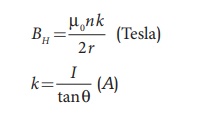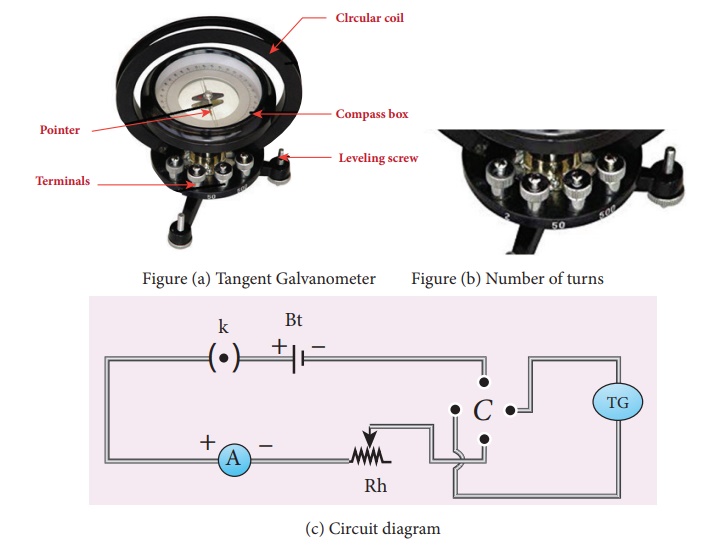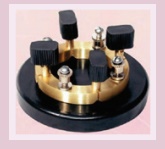Physics Practical Experiment - Horizontal Component of EarthŌĆÖs Magnetic Field Using Tangent Galvanometer | 12th Physics : Practical
Chapter: 12th Physics : Practical
Horizontal Component of EarthŌĆÖs Magnetic Field Using Tangent Galvanometer
HORIZONTAL COMPONENT OF EARTHŌĆÖS
MAGNETIC FIELD USING TANGENT GALVANOMETER
AIM
To
determine the horizontal component of the EarthŌĆÖs magnetic field using tangent
galvanometer.
APPARATUS REQUIRED
Tangent
galvanometer (TG), commutator, battery, rheostat, ammeter, key and connecting
wires.
FORMULA

where,
BH
ŌåÆ Horizontal component of the EarthŌĆÖs magnetic field (T)
┬Ą0
ŌåÆ Permeability of free space (4ŽĆ ├Ś 10ŌłÆ7 H mŌłÆ1)
n
ŌåÆ Number of turns of TG in the circuit (No unit)
k
ŌåÆ Reduction factor of TG (A)
r
ŌåÆ Radius of the coil (m)
CIRCUIT DIAGRAM

PROCEDURE
┬Ę
The preliminary adjustments are carried
out as follows.
a.
The leveling screws at the base of TG are adjusted so that the circular turn
table is horizontal and the plane of the circular coil is vertical.
b.
The circular coil is rotated so that its plane is in the magnetic meridian
i.e., along the north-south direction.
c.
The compass box alone is rotated till the aluminium pointer reads 0┬░ ŌłÆ 0┬░.
┬Ę
The connections are made as shown in
Figure (c).
┬Ę
The number of turns n is selected and
the circuit is switched on.
┬Ę
The range of current through TG is
chosen in such a way that the deflection of the aluminium pointer lies between
30┬░ ŌłÆ 60┬░.
┬Ę
A suitable current is allowed to pass
through the circuit, the deflections ╬Ė1 and ╬Ė2 are noted from two ends of the
aluminium pointer.
┬Ę
Now the direction of current is reversed
using commutator C, the deflections ╬Ė3 and ╬Ė4 in the opposite direction are
noted.
┬Ę
The mean value ╬Ė of ╬Ė1, ╬Ė2,
╬Ė3 and ╬Ė4 is calculated and tabulated.
┬Ę
The reduction factor k is calculated for
each case and it is found that k is a constant.
┬Ę
The experiment is repeated for various
values of current and the readings are noted and tabulated.
┬Ę
The radius of the circular coil is found
by measuring the circumference of the coil using a thread around the coil.
┬Ę
From the values of r, n and k, the
horizontal component of EarthŌĆÖs magnetic field is determined.
Commutator:
It
is a kind of switch employed in electrical circuits, electric motors and
electric generators. It is used to reverse the direction of current in the
circuit.

OBSERVATION
Number
of turns of the coil n =
Circumference
of the coil (2ŽĆr) =
Radius of the coil r =

CALCULATION

RESULT
The
horizontal component of EarthŌĆÖs magnetic field is found to be ________
Note:
i)
The magnetic materials and magnets present in the vicinity of TG should be
removed.
ii)
The readings from the ends of the aluminium pointer should be taken without
parallax error.
iii)
The deflections of TG is restricted between 30┬░ and 60┬░. It is because, the TG
is most sensi tive for deflection around 45┬░ and is least sensitive around 0┬░
and 90┬░. We know that
I
= k tan ╬Ė
or
dI =k sec2 ╬Ė d╬Ė
d╬Ė/
dI = sin2╬Ė / 2I
For
given current, sensitivity d╬Ė / dI maximum for sin 2╬Ė = 1 or ╬Ė = 45┬░
Related Topics